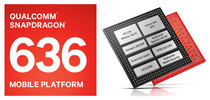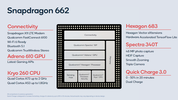Qualcomm Snapdragon 636 vs Qualcomm Snapdragon 6s 4G Gen 1 vs Qualcomm Snapdragon 660
Qualcomm Snapdragon 636
► remove from comparison
The Qualcomm Snapdragon 636 (SDM636) is a mid-range octa-core SoC with eight custom Kryo 260 cores at up to 1.8 GHz, an Adreno 509 GPU, a LPDDR4-2666 memory controller (1333 MHz) and a X12 LTE (Cat 12/13, 300 Mbps down, 150 Mbps up) modem. Furthermore, the chip supports 802.11ac WiFi and Bluetooth 5.0. It is manufactured in 14nm FinFet. Qualcomm states a 40% faster performance compared to the old Snapdragon 630 (8x ARM Cortex-A53).
Qualcomm Snapdragon 6s 4G Gen 1
► remove from comparison
The Qualcomm Snapdragon 6s 4G Gen 1 (SM6115-AC) is a renamed Snapdragon 662 SoC of the lower mid-range for (Android based) smartphones and tablets. The processor unit contains 8 Kryo-260 CPU cores (4x ARM Cortex-A73 with up to 2.1 GHz and 4x ARM Cortex-A53 with up to 1.8 GHz). The Qualcomm Adreno 610 is used as the graphics unit
The SoC comes with the third generation of Qualcomm's AI Engine and also includes Bluetooth 5.1. It is interesting to note that Qualcomm describes the Wi-Fi capability as "WiFi-6-ready", meaning you can connect to a WiFi 6 network, but not all parts of the standard are supported. The new WPS3 security protocol can be used. Support for the HEIF image file format and the Indian satellite network NavIC are also new.
The performance should be very similar to the old Snapdragon 662 (see for benchmarks).
The Snapdragon X11 is integrated as an LTE modem, which supports LTE Cat.13 in the uplink and downlink, as well as 2x2 MIMO in the downlink. The maximum transmission speed is 390 MBit/s (download) and 150 MBit/s (upload).
In terms of mass storage, a maximum of UFS 2.1 is supported, the memory limits are 32 GB and LP4x.
The SoC is manufactured using the 11 nm process.
Qualcomm Snapdragon 660
► remove from comparison
The Qualcomm Snapdragon 660 (SD660) is a fast mid-range ARM-based SoC largely found on Android tablets and smartphones. Announced in mid 2017, the SD660 is the successor to the Snapdragon 625. It features 8 Kryo 260 cores (custom design, 64-Bit capable) that are divided in two clusters. A fast cluster of four cores with up to 2.2 GHz and a power saving efficiency cluster with up to 1.8 GHz. Both clusters can also used together.
In addition to the 8 CPU cores, the SoC integrates a mid range Adreno 512 GPU with a LPDDR4 memory controller (dual-channel 1866 MHz) and supports Wi-Fi (802.11ac + MIMO, max. 867 Mbps), Bluetooth 5, and LTE (X12 LTE modem with up to 600 Mbps download and 150 Mbps upload).
Performance
In Benchmarks of the Oppo R11, the CPU part of the Snapdragon SD660 performs between former high end Socs like the Snapdragon 821 in the Pixel XL and the Snapdragon 835. The graphics performance is however much lower, as the Adreno 512 is only a slight upgrade of the older Adreno 510 (due to the higher clock speed).
CPU
The Snapdragon 660 is based on a similar concept as ARM's big.LITTLE, which combines a low power CPU cluster (2x Kyro clocked at up to 1.8 GHz) and a performance CPU cluster (2x Kyro clocked at up to 2.2 GHz). The clock speed of each cluster can be individually adjusted (but not per core) and the lowest clock speed is 310 MHz (unverified).
Power Consumption
Thanks to the new 14 nm process, the energy efficiency has been improved noticeably compared to its 20 nm predecessors.
| Model | Qualcomm Snapdragon 636 | Qualcomm Snapdragon 6s 4G Gen 1 | Qualcomm Snapdragon 660 | ||||||||||||||||||||||||||||||||||||||||||||||||||||||||||||
| Codename | Kryo 260 | Kryo 260 | Kryo 260 | ||||||||||||||||||||||||||||||||||||||||||||||||||||||||||||
| Series | Qualcomm Snapdragon | Qualcomm Snapdragon | Qualcomm Snapdragon | ||||||||||||||||||||||||||||||||||||||||||||||||||||||||||||
| Series: Snapdragon Kryo 260 |
|
|
| ||||||||||||||||||||||||||||||||||||||||||||||||||||||||||||
| Clock | 1800 MHz | 1800 - 2100 MHz | 2200 MHz | ||||||||||||||||||||||||||||||||||||||||||||||||||||||||||||
| Cores / Threads | 8 / 8 | 8 / 8 ARM Cortex-A53 | 8 / 8 | ||||||||||||||||||||||||||||||||||||||||||||||||||||||||||||
| Technology | 14 nm | 11 nm | 14 nm | ||||||||||||||||||||||||||||||||||||||||||||||||||||||||||||
| Features | Adreno 509 GPU, X12 LTE Modem, Hexagon 680 DSP, Spectra 160 ISP | Adreno 610 GPU, X11 LTE Modem, Hexagon 683 DSP, Specra 340T ISP | Adreno 512 GPU, X12 LTE Modem, Hexagon 680 DSP, Specra ISP | ||||||||||||||||||||||||||||||||||||||||||||||||||||||||||||
| iGPU | Qualcomm Adreno 509 | Qualcomm Adreno 610 ( - 1050 MHz) | Qualcomm Adreno 512 ( - 850 MHz) | ||||||||||||||||||||||||||||||||||||||||||||||||||||||||||||
| Architecture | ARM | ARM | ARM | ||||||||||||||||||||||||||||||||||||||||||||||||||||||||||||
| Announced | |||||||||||||||||||||||||||||||||||||||||||||||||||||||||||||||
| Manufacturer | www.qualcomm.com | www.qualcomm.com |
Benchmarks
Average Benchmarks Qualcomm Snapdragon 636 → 0% n=0
Average Benchmarks Qualcomm Snapdragon 6s 4G Gen 1 → 0% n=0
Average Benchmarks Qualcomm Snapdragon 660 → 0% n=0
* Smaller numbers mean a higher performance
1 This benchmark is not used for the average calculation













